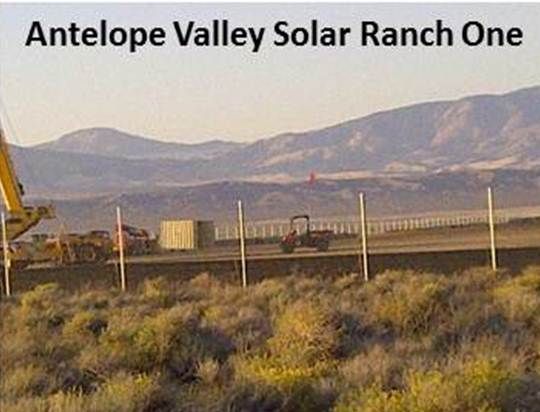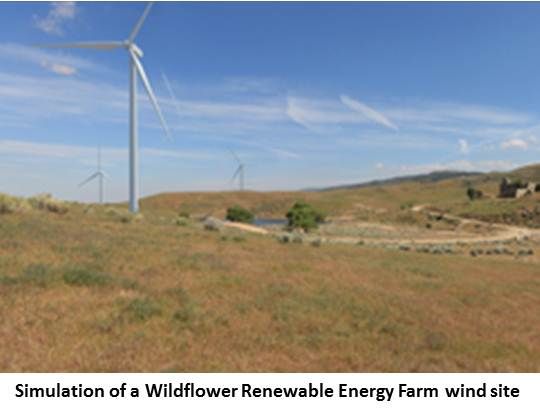People from a wide array of backgrounds and means in the renewables-rich Antelope Valley are confronting a development explosion comparable to earlier centuries’ gold rushes and oil booms.
Early indications of the proportion of what is coming are First Solar’s Antelope Valley Solar Ranch One, a 230-megawatt solar photovoltaic project that will be one of the world’s biggest solar power plants, and Element Power’s Wildflower Renewable Energy Farm, a 250-megawatt combined solar and wind project that will be the world’s biggest renewables hybrid plant.
Most Valley residents are still trying to grasp the implications of tens of thousands of acres of mountainsides and valley floor being turned into a renewable energy mecca, though some are seizing the profit-taking opportunity or rebelling.
It is happening so fast that Robert -- a thoughtful longtime Valley resident -- noted with suspicion at the most recent Antelope Acres Town Council meeting that he suspects developers are trying to get footholds before Los Angeles County Regional Planning can complete its guidelines, which he believes will limit development.
Robert is partly wrong because county, state and federal agencies are already managing development, but at the same time, he is partly right, because, in pursuit of the enormous opportunity offered up by the state’s 33 percent renewables by 2020 mandate, the race is on.
Sixty-one solar projects representing 3,340 megawatts and 20 wind projects representing some 2,500 megawatts are in permitting, according to the California Energy Commission. Many more are planned.
A recent Antelope Acres community meeting was well attended because it was rumored First Solar would be there to discuss some $200,000 in funds voluntarily promised by the company to benefit the community, some of which has already been provided. Company representatives did not, in fact, attend.

Margaret Rhyne was there to raise concerns about the dangers of meteorological (met) towers held up by guy wires. Met towers are used by wind developers to precisely record a site’s potential. Without a year of data, developers cannot obtain financing for their multi-hundred-million-dollar undertakings.
Guy wires, Rhyne said, could endanger the region’s avian species, especially “20 bird species and 10 bat species that are found in [the proposed 200-megawatt NextEra Energy Blue Sky wind project] area, or nearby, that are ‘rare, endangered, or sensitive species.’”
Rhyne told the Council of a June California Department of Fish and Game statement that “avian fatalities at individual met towers equaled or exceeded the rates attributed to any single turbine.”
She did not mention the fact that only 1.5 of every 10,000 birds killed by human-related factors is from a wind turbine.
John Calvert followed Rhyne. He believes, he told the Council, that cutting-edge lidar laser technology and sodar radar technology are both viable alternatives to guyed met towers, are even more accurate, and are gaining acceptance with financial institutions.
But advanced technologies, Nat Parker, the Wildflower Project Manager for Element Power, explained when he took the floor, are “not bankable.” Financial institutions do not accept lidar and sodar readings in place of met tower readings. That is why there are lidar, sodar, and guyed met towers, with bird diverters on the guy wires, at the proposed Wildflower site.

Rhyne responded that Fish and Game had noted there is “no proof bird diverters work.”
Parker ended by reporting that the results of Element Power’s extensive environmental impact studies of its site, performed over more than a year, will soon be made public. He asked the Council and residents to study them. “Let’s be scientific,” he said, adding, “we invite your input.”
Kevin Simpson raised what he called “a common sense question” about the threat of the many guyed radio towers in the Valley.
Rhyne said they were “just as threatening, if not more” (but did not call for a stop to radio).
Another longtime resident observed that there have been power lines and transmission towers throughout Antelope Valley “for years without a problem.”
Simpson added that climate change is also a danger to birds and pointed out that the Valley will likely either have development of residential real estate or renewables. “What’s the difference between thousands of new homes with commuters driving daily across the Valley floor, and solar and wind projects?” he asked. “I’m not a corporate stooge,” he said, “but sometimes it’s the lesser of two evils. Nothing’s perfect.”
“But why,” Robert wanted to know, “are we the ones that have to suffer to stop climate change? Where else are they doing this?” he demanded.
“We don’t want to sacrifice,” Calvert added, “so that people in Los Angeles can have power.”
“When I visit my son in Germany,” a resident said near the end of the debate, “they have these towers everywhere. But they’re doing it because they’re not going to use nuclear anymore. When you talk about the lesser of two evils, this is the way to go.”
During the meeting, Colleen, frustrated because First Solar was not in attendance, attacked the Town Council President for allegedly having undisclosed meetings with First Solar. (See video below.)
“You need to be more open,” Colleen lectured the Council President to applause from the attendees.
The meeting was an inspiring display of democracy in action, though it is not yet clear whether the citizens of Antelope Valley will choose to live with renewables.
A citizen confronts her town council president over First Solar mitigation monies.



